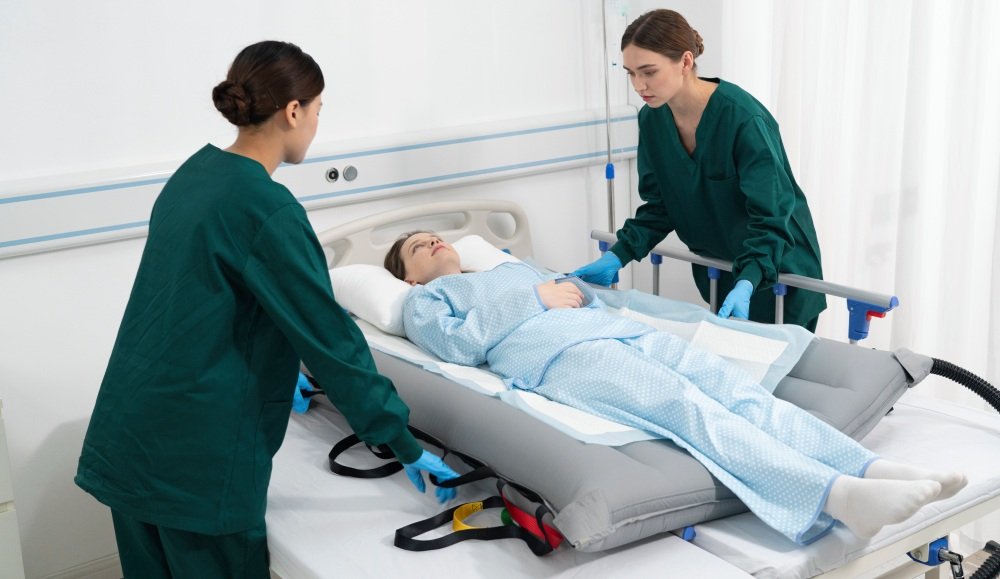Modern healthcare is constantly evolving, with a growing emphasis on patient safety, caregiver well-being, and efficient workflows. One technology playing an increasingly vital role in achieving these goals is the air transfer mattress. This comprehensive guide will delve into the world of air transfer mattresses, exploring their principles, benefits, applications, and how they are becoming indispensable in modern healthcare settings.
1. Introducing Air Transfer Mattresses: A Modern Healthcare Essential
Air transfer mattresses, also known as air-assisted transfer systems or air flotation mattresses, are specialized medical devices designed to facilitate safe and effortless patient transfers. They represent a significant departure from traditional manual lifting methods, leveraging air flotation technology to minimize friction and strain.
2. How Air Transfer Mattress Technology Works: The Science of Air Flotation
The core principle behind air transfer mattresses is ingeniously simple yet highly effective: air flotation. Here’s a breakdown of how this technology works:
- Inflation and Air Cushion: The mattress is inflated using an external air supply, creating a pressurized cushion of air beneath the patient.
- Perforated Surface for Air Distribution: The underside of the mattress features strategically placed perforations that evenly distribute the air cushion across the entire surface area in contact with the supporting bed or surface.
- Near-Frictionless Interface: This consistent layer of air creates a near-frictionless interface between the patient and the supporting surface. This dramatically reduces the force required to move the patient laterally.
- Effortless Gliding Motion: With friction virtually eliminated, caregivers can effortlessly glide and reposition patients with minimal physical exertion.
- Controlled and Stable Transfers: Despite the near-frictionless surface, air transfer mattresses allow for controlled and stable patient movement, ensuring safety throughout the transfer process.
3. Key Benefits of Air Transfer Mattresses: Safety, Efficiency, and Well-being
The adoption of air transfer mattresses offers a multitude of benefits across the healthcare spectrum:
- Enhanced Patient Safety:
- Reduced Skin Shear and Friction: Minimizes the risk of skin tears, bruising, and pressure ulcers by eliminating friction during transfers.
- Minimized Risk of Falls: Provides a stable and controlled transfer platform, reducing the likelihood of accidental drops and falls.
- Improved Patient Comfort: Offers a gentler and more comfortable transfer experience, reducing anxiety and discomfort, especially for sensitive patients.
- Increased Patient Dignity: Promotes respectful and dignified patient handling during necessary transfers and repositioning.
- Reduced Caregiver Strain and Injuries:
- Minimizes Manual Lifting: Significantly reduces the physical demands of patient transfers, addressing the primary cause of musculoskeletal injuries (MSIs) among caregivers.
- Ergonomic Workflow: Promotes ergonomic patient handling techniques, decreasing physical stress and strain on caregivers’ bodies.
- Lower Workers’ Compensation Costs: Reduces the incidence of caregiver injuries, leading to lower workers’ compensation claims and associated financial burdens.
- Improved Staff Retention: Contributes to a safer and more supportive work environment, enhancing staff morale and reducing turnover rates.
- Improved Workflow Efficiency:
- Faster Transfer Times: Air-assisted transfers are generally quicker and smoother than manual methods, saving valuable time in busy healthcare settings.
- Reduced Staffing Needs: Often requires fewer caregivers per transfer compared to traditional methods, optimizing staff utilization and resource allocation.
- Streamlined Patient Handling Procedures: Simplifies and streamlines patient transfer protocols, contributing to a more efficient and organized workflow.
- Increased Throughput: Contributes to improved patient throughput, particularly in high-demand areas like emergency departments and operating rooms.
4. Diverse Applications Across Modern Healthcare
Air transfer mattresses are remarkably versatile and find applications in various healthcare settings:
- Hospitals (Medical-Surgical Units, ICUs, ORs, EDs): For lateral transfers between beds and stretchers, transfers to operating tables and imaging equipment, and repositioning within beds.
- Long-Term Care Facilities and Nursing Homes: For frequent and safe repositioning and transfers of residents with limited mobility, reducing caregiver strain and preventing pressure ulcers.
- Rehabilitation Centers: For facilitating safe and controlled transfers during therapy sessions, promoting patient participation and reducing the risk of injury during rehabilitation.
- Home Healthcare: To empower home caregivers to safely and effectively manage patient transfers within the home environment, making home care more manageable and sustainable.
- Emergency Medical Services (EMS): For rapid and secure patient transfers in emergency situations, in ambulances and emergency departments, where time and safety are critical.
- Bariatric Care: Air transfer mattresses are particularly beneficial for handling bariatric patients, providing the necessary support and reducing strain on caregivers when moving heavier individuals.
5. Key Features to Consider When Choosing an Air Transfer Mattress
When selecting an air transfer mattress for your facility, consider these key features:
- Weight Capacity: Ensure the mattress weight capacity meets the needs of your patient population, particularly if you handle bariatric patients.
- Size and Dimensions: Choose sizes that are appropriate for your beds, stretchers, and patient transfer needs. Consider various widths and lengths.
- Material Durability and Comfort: Look for mattresses made from durable, cleanable, and comfortable materials that prioritize patient skin integrity and longevity.
- Ease of Use and Operation: Opt for user-friendly systems with intuitive controls, quick inflation/deflation mechanisms, and simple setup procedures.
- Portability and Storage: Consider the portability and storage requirements of the mattress, especially for facilities with limited space or the need for mobile units.
- Power Source and Requirements: Evaluate the power source (e.g., electric pump, compressed air) and ensure compatibility with your facility’s infrastructure.
- Safety Features: Look for mattresses with safety certifications, robust construction, and features like pressure relief valves and secure patient straps (if needed).
- Cost and Return on Investment (ROI): Evaluate the initial cost and consider the long-term ROI based on reduced injuries, improved efficiency, and other benefits.
6. Implementing Air Transfer Mattresses: Best Practices for Success
Successful implementation of air transfer mattress technology requires more than just purchasing equipment. Consider these best practices:
- Comprehensive Staff Training: Provide thorough training to all staff members on the safe and effective use of air transfer mattresses, including proper techniques, troubleshooting, and maintenance.
- Integration into Protocols and Policies: Update patient handling protocols and policies to incorporate air transfer mattress utilization, ensuring consistent and appropriate use.
- Champion and Education: Identify a champion within your organization to promote the benefits of air transfer mattresses and educate staff on their proper use and advantages.
- Regular Maintenance and Inspection: Establish a schedule for regular cleaning, inspection, and maintenance of air transfer mattresses to ensure optimal performance and longevity.
- Ongoing Monitoring and Evaluation: Track the impact of air transfer mattress implementation on staff injuries, patient outcomes, and workflow efficiency to continuously improve and optimize utilization.
7. Conclusion: Air Transfer Mattresses – Transforming Modern Healthcare
Air transfer mattresses are no longer a niche technology; they are becoming a cornerstone of modern healthcare. By prioritizing patient and staff safety, enhancing workflow efficiency, and contributing to a more compassionate care environment, air transfer mattresses are proving to be an invaluable asset. Embracing this technology is a crucial step for healthcare facilities committed to providing the highest quality care in the 21st century and beyond.

